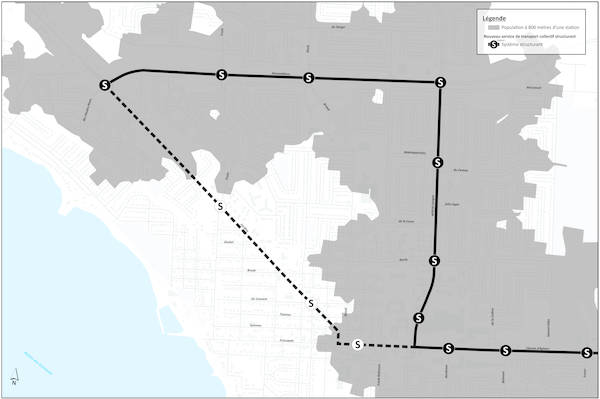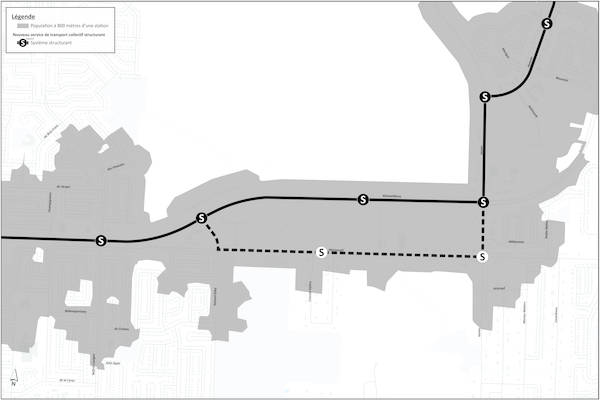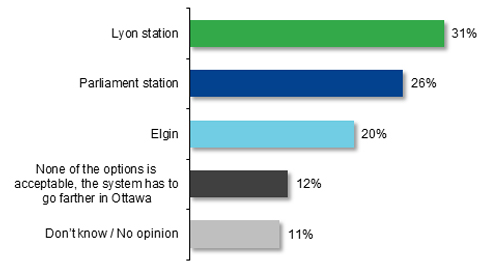Public consultation results - Future structuring link in the west
From June 3 to 24, 2019, the STO held a series of public consultations to give the public a chance to comment on the five scenarios currently under study for the future structuring link in the west.
- News release unveiling the public consultation results (in French only)
- Full and detailed report on the public consultation results (in French only)
- Annexes (in French only)
- Technical briefing (in French only)
Methodology
This consultation process had two components:
- Information:
Three evening sessions with five short videos, online documentation and information kits. - Consultation:
Online and hard copy questionnaire, brainstorming workshop and opportunity to submit briefs.
Number of respondents
- 668 questionnaires filled out by a variety of residents
- 71% of residents in the West sectors of Gatineau, 29% from other sectors
- 73% of public transit users, 27% non-users
- 100 participants at the information evenings
- 22 participants at the brainstorming workshop
- 11 briefs received
The consultation was generally appreciated by respondants :
- 95% found the terms used simple and easy to understand
- 91% say they could express their preferences and concerns
- 89% were satisfied with the information available on the STO website
Consultation highlights
What you told us
The large majority of respondents believe that a structuring link needs to be introduced in the western part of Gatineau, almost as many in the West sectors (81%) as in the other sectors (72%).
The scenarios
According to the responses received, a tram scenario is seen as more efficient, reliable, ecological and viable over the long term, and faster.
Possible variations
In regard to the different variations, there were a few clear preferences.
Respondents wanted the structuring link to pass through Allumettières/Wilfrid-Lavigne (48%) instead of Eardley/Principale (16%) because, according to them, this option would:
- reduce the impact on shoreline residents and businesses;
- allow more space for a structuring link; and
- provide better service to homes and businesses.
The back of UQO is preferred (53%) to boulevard Taché (24%) because respondents felt that it would:
- reduce the impact on shoreline residents;
- allow more space for a structuring link;
- leave room for automobiles on the other axis (boulevard Taché);
- provide a faster route; and
- provide better access to UQO.
Transfers
*Given that this question mainly concerns residents in the other sectors, their responses are the ones that are presented below.
Residents in the other sectors* feel that it might be acceptable to transfer to a potential tram to Ottawa under the following conditions:
- if the route to Ottawa can avoid congestion (50%);
- if the tram and buses run frequently (49%); and
- if the trip is shorter (42%).
Downtown Ottawa
Infrastructure
- most (64 to 76%) of respondents seem willing to accept fewer lanes for automobiles;
- between 44% and 59% are willing to accept partial expropriations; and
- only a minority (24 to 42%) are willing to accept total expropriations.

Use of results
The information obtained through the public consultations will be taken into account at different stages of the project, including in the detailed layout and the factors for comparing the different scenarios under this project, as well as in the upcoming design stages.
Next steps
- additional targeted consultations will take place with the consultative committees and the residents in the directly affected neighbourhoods;
- the final study report will be tabled during the winter of 2021/2022; and
- there will be several additional steps, including getting funding, developing plans and specifications, and the actual construction. The new system is expected to be ready in 8 to 10 years.
Until then, in order to meet the increased traffic in the west as in the east, the STO will continue to invest heavily and to implement the most efficient ways of improving its system's performance and reliability. By the fall of 2019, it should be noted that the STO has injected $4 M into its offer of service, which has led to 24,400 additional hours and 524,500 additional kilometres for customers. Many of those changes benefited the western part of Gatineau.
Partners involved
Given the geographic layout and the inter-provincial nature of the project, the study is being conducted in collaboration with the STO's partners: Ville de Gatineau, Quebec's ministère des Transports, the National Capital Commission, the City of Ottawa and OC Transpo.
This study is being financed by contributions from the federal government (50%) and provincial government (40%) under the financial assistance program of the Public Transit Infrastructure Fund (PTIF).
Previous steps
- Structuring link in the west
- Opportunity study










